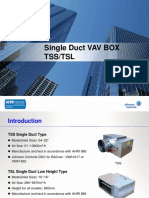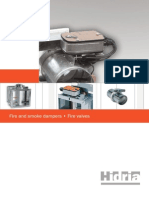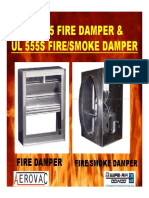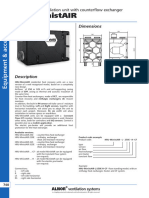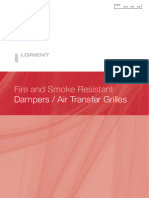Cethar Vessels LTD: 23.0.0 High Energy Electric Ignition (HEEI) System
Cethar Vessels LTD: 23.0.0 High Energy Electric Ignition (HEEI) System
Uploaded by
SureshYarlagaddaCopyright:
Available Formats
Cethar Vessels LTD: 23.0.0 High Energy Electric Ignition (HEEI) System
Cethar Vessels LTD: 23.0.0 High Energy Electric Ignition (HEEI) System
Uploaded by
SureshYarlagaddaOriginal Description:
Original Title
Copyright
Available Formats
Share this document
Did you find this document useful?
Is this content inappropriate?
Copyright:
Available Formats
Cethar Vessels LTD: 23.0.0 High Energy Electric Ignition (HEEI) System
Cethar Vessels LTD: 23.0.0 High Energy Electric Ignition (HEEI) System
Uploaded by
SureshYarlagaddaCopyright:
Available Formats
Customer M/s.
Meenakshi energy P Ltd
CETHAR VESSELS LTD Project 2 x 300 MW PC Fired boiler
TIRUCHIRAPALLI - 620001 Doc. No. BJ087-00-08-4-006
Rev A Page 18 of 19
23.0.0 High Energy Electric Ignition (HEEI) System
• In the igniter a pulsed arc, capacitive discharge, high-energy electric ignition (HEEI) spark
system for improving igniter reliability. The spark system consists of a spark exciter, spark
cable, spark rod, and replaceable spark tip. The spark rod fits through the spark guide pipe
and has a separate retract assembly so that it can be retracted after ignition trial time. The
retract assembly is equipped with one pneumatic cylinder, one 4-way, single-coil solenoid and
two DPDT heavy-duty limit switches to indicate spark tip position.
• Cable connects the spark rod to the exciter and is provided in lengths as necessary, encased
in flexible watertight conduit. The spark rod utilizes a replaceable tip. The spark rod operates
from a fixed position to provide reliable lightoff of the igniter fuel. The 12-Joule spark system
is powered by 230 VAC/5A and provides a minimum 4 sparks per second. Each power pack
includes five LEDs located on the PC Board for troubleshooting. The igniter is classified in
NFPA as class III – interrupted igniter.
• Cooling air is provided from scanner cooling air fan outlet. The quantity is 100 kg/hr per Igniter
@ 250 mmwc above the wind box pressure.
A
24.0.0 Flame Monitoring System
A flame monitoring system provided to monitor the oil and coal flame in the burners and
integrated with BMS. The scanners can work with wide range of fuels and the scanners can
be easily tuned to the different operating conditions. Total number of burners provided in this
contract are Twenty four (24) and each burner is provided with one scanner for oil flame
detection and one scanner for coal flame detection. The scanner works with infrared flame
flicker frequency and intensity detection as per the established standard practice of Riley
burners, and in conformance with NFPA recommendations. The scanners are equipped with
auto diagnostic feature with self check facility.
Scanners are arranged in a clear sight path to the base of the oil/coal flame in the primary
combustion zone under all operating conditions. The scanners are mounted in the burner
front at the secondary air annular zone. Each scanner will provide optimal flame detection and
discrimination. The scanner does not respond to the adjacent or background radiation
generated in the furnace. The design takes care of the shrouding of flame by coal/ash dust.
During starting with oil firing, the oil scanner will sense the oil flame and is connected to the
BMS. When coal firing is started, both oil and coal flame will be sensed and both the scanners
will vote for the burner flame being present. Presence of oil flame or coal flame as voted by
their scanners, will permit the burner to continue the firing.
Scanner is capable of Digital Safe Flame Communications (DsfComm) for graphical user
interface. The DsfComm application is used to monitor burner-flame status, to display data,
and for programming flame scanners.
24.1.0 Mechanical details of scanners :
• Sensitivity : Response time : 1-4 seconds adjustable
• Ambient: -300 to 700C
• Humidity: 100% Condensing
• Max. Internal Temperature 850C – Takes care of momentary interruption in cooling air.
• NEMA 4X (IP66)/ NEMA 7 Class 1, Division 1 & 2, Groups B,C & D (ATEX)
• Approvals: UL & FM approved.
• Cooling air : 20 kg/hr per scanner @ 375 mmwc above the wind box pressure. A
Prepared by Checked by Approved by
Name S.Thirumoorthy V. Loganathan K.P.A.Jaffer ali
Signature
Customer M/s. Meenakshi energy P Ltd
CETHAR VESSELS LTD Project 2 x 300 MW PC Fired boiler
TIRUCHIRAPALLI - 620001 Doc. No. BJ087-00-08-4-006
Rev A Page 19 of 19
24.2.0 Electrical interface of scanners :
• 230 V AC to 24VDC, 2.9VA (120mA) as input
• Flame on contact: N.O. relay Contact
• Flame signal: 4-20mA
24.3.0 Scanner cooling air system :
Two scanner air fans are provided for suppling cooling air to the scanners. The normal
running fan is operated by AC power and the standby fan is provided with DC power. The
scanner air fan discharge damper is auto transfer damper operated by the air pressure from
the fans. The fan suction is taken from atmosphere and hence no emergency air damper is
required at the suction to connect the fan to atmosphere. The fan control will be provided in
the control desk with necessary console inerts. Refer PID BJ087-00-05-3-010 for the scheme
of scanner cooling air system.
24.3.1 Sizing criteria:-
• Type : Centrifugal fan.
• Margin : 20% in flow & 30% in head.
• Ambient temperature : 50°C.
• Fan speed : 3000RPM.
Sl. No. Description Scanner cooling air fan parameters in Test
block condition
1 Flow 1.24 m^3/sec or 4460 m^3/hr
2 Head 660 mmwc
3 Temperature 50°C
4 Motor rating 18.5 KW
Prepared by Checked by Approved by
Name S.Thirumoorthy V. Loganathan K.P.A.Jaffer ali
Signature
You might also like
- Control & Operation Philosophy of AcDocument24 pagesControl & Operation Philosophy of Acjhandu100% (2)
- 6d KEP Technology UpdateDocument4 pages6d KEP Technology UpdatecuongckNo ratings yet
- cOMMISSIONING 1 - WorksheetDocument60 pagescOMMISSIONING 1 - WorksheetPramod Dhir100% (1)
- S220-Rankine Cycle Steam TurbineDocument3 pagesS220-Rankine Cycle Steam TurbineMuhammad RehanNo ratings yet
- Report On Inplant TrainingDocument20 pagesReport On Inplant TrainingLokesh Babu50% (4)
- Iecre We TC 19 0043-R0Document9 pagesIecre We TC 19 0043-R0AvijitSinharoyNo ratings yet
- Itp - HvacDocument3 pagesItp - HvacAbdulah Asagi100% (3)
- Multi DetailsDocument4 pagesMulti DetailsVinod MishraNo ratings yet
- Aquadry LA-RLA ENG PDFDocument2 pagesAquadry LA-RLA ENG PDFtamanogNo ratings yet
- Flame Scanner Catalogue 2019Document8 pagesFlame Scanner Catalogue 2019mohan babuNo ratings yet
- Cu 104Document16 pagesCu 104PonyPantsNo ratings yet
- Fire Protection and Fire Fighting System - Rev 4Document12 pagesFire Protection and Fire Fighting System - Rev 4Samit DasNo ratings yet
- Product Catalogue PDFDocument38 pagesProduct Catalogue PDFleanhhaievn_95463721100% (1)
- Mobile Flare StackDocument4 pagesMobile Flare StackMurat KalfaNo ratings yet
- CESC LTD Converted 1Document40 pagesCESC LTD Converted 1Sparsh GuptaNo ratings yet
- Techinical - Specification - 15kv-Distribution TransfrormerDocument55 pagesTechinical - Specification - 15kv-Distribution TransfrormerEyoNo ratings yet
- Sop Ldo SystemDocument8 pagesSop Ldo Systemjp mishraNo ratings yet
- S220-Rankine Cycle Steam TurbineDocument2 pagesS220-Rankine Cycle Steam TurbineIlyas EloufiriNo ratings yet
- Advanced Cycles JIPTDocument26 pagesAdvanced Cycles JIPTjp mishraNo ratings yet
- Wide Range Semiconductor Flow Sensors: Sensors and Actuators A Physical August 2000Document9 pagesWide Range Semiconductor Flow Sensors: Sensors and Actuators A Physical August 2000ThiệnTâmNguyễnNo ratings yet
- 2.catalogue - HEA Igniter System BCPLDocument6 pages2.catalogue - HEA Igniter System BCPLVishesh BankarNo ratings yet
- 3 Esp .Document6 pages3 Esp .Mithun Singh Rajput100% (1)
- Electrostatic Precipitator Esp Converted 1Document58 pagesElectrostatic Precipitator Esp Converted 1vijayragavan2114No ratings yet
- Vizag Steel Plant Vizag Captive Power Plant High Pressure Governing Oil SystemDocument33 pagesVizag Steel Plant Vizag Captive Power Plant High Pressure Governing Oil Systemurs5100% (1)
- Flarecatcher 10000-65 - Spec SheetDocument1 pageFlarecatcher 10000-65 - Spec SheetjohnNo ratings yet
- Technology Development, Design and Safety Features of PHWR and Their Operating PerformanceDocument57 pagesTechnology Development, Design and Safety Features of PHWR and Their Operating PerformanceLuptonga100% (3)
- Commercial & Technical Proposal For 10MW - 11 KV MWM DEUTZ Gas Engine Power PlantDocument15 pagesCommercial & Technical Proposal For 10MW - 11 KV MWM DEUTZ Gas Engine Power PlantSojib hossain100% (2)
- SC Annex 4-Specification and Description of The Equipment Rev2 (Turbine Kawasaki)Document20 pagesSC Annex 4-Specification and Description of The Equipment Rev2 (Turbine Kawasaki)Marius PiciorusNo ratings yet
- DaikinAppliedEu 20220719Document4 pagesDaikinAppliedEu 20220719ahmed ragabNo ratings yet
- 420010325701A Instructiuni de Utilizare VL4.610DDocument28 pages420010325701A Instructiuni de Utilizare VL4.610DvladalucarDNo ratings yet
- Opgs 0 BLR Opn 19-29-00 Sop For CCCW SystemDocument7 pagesOpgs 0 BLR Opn 19-29-00 Sop For CCCW SystemAnbu MathiNo ratings yet
- Transformers Oil Filtration MachineDocument4 pagesTransformers Oil Filtration MachinePintu BeheraNo ratings yet
- Sensor Systems Broch 09 MedDocument12 pagesSensor Systems Broch 09 MedscribdkhatnNo ratings yet
- DT Gen-Technical Data Sheet - DTG640C-2023Document1 pageDT Gen-Technical Data Sheet - DTG640C-2023chris connorsNo ratings yet
- Aqt-50 - (50 & 60 HZ) - Perkins - 1103-33TG1 (50 Kva)Document4 pagesAqt-50 - (50 & 60 HZ) - Perkins - 1103-33TG1 (50 Kva)khaled kamelNo ratings yet
- Calculation and Analysis of Critical Heat Flux atDocument16 pagesCalculation and Analysis of Critical Heat Flux atAmairani Fuentes AndradeNo ratings yet
- Refrigeration Test RigDocument1 pageRefrigeration Test RigVirender Rana0% (1)
- DT Gen-Technical Data Sheet - DTG1125C-2023Document1 pageDT Gen-Technical Data Sheet - DTG1125C-2023chris connorsNo ratings yet
- Materi CPNS 2018Document15 pagesMateri CPNS 2018Selvi OktavianaNo ratings yet
- BHELSPARKDocument24 pagesBHELSPARKExecutive EngineerNo ratings yet
- Pt. Cilegon Fabricators: PWHT Procedure FOR PT - Pertamina Ru Vi BalonganDocument10 pagesPt. Cilegon Fabricators: PWHT Procedure FOR PT - Pertamina Ru Vi BalonganDedy Trianda100% (1)
- Condensate Return: Product Application DataDocument2 pagesCondensate Return: Product Application DataVanessa VanegasNo ratings yet
- Technical PG620 (Rev)Document7 pagesTechnical PG620 (Rev)W Winarto100% (1)
- Fuel Oil Firing System Write Up - BaraDocument32 pagesFuel Oil Firing System Write Up - BaraJAYKUMAR SINGHNo ratings yet
- WPL 2 Low Dynamic PressureDocument10 pagesWPL 2 Low Dynamic Pressuretw2skgfcmhwtgh2pw04No ratings yet
- Heat Treatment of Thin Wall Tanks by Internal Oil Firing MethodDocument7 pagesHeat Treatment of Thin Wall Tanks by Internal Oil Firing MethodKrishna VachaNo ratings yet
- Experimental Simulation of Heat Genrated in ReactorDocument5 pagesExperimental Simulation of Heat Genrated in Reactorkrunal teliNo ratings yet
- Super Silent, Superior Life!: WPS300/S - Technical Data SheetDocument6 pagesSuper Silent, Superior Life!: WPS300/S - Technical Data SheetSteven E. EsquivelNo ratings yet
- 5-4842 - SOP Oxyfuel Burner & Pressure VesselDocument14 pages5-4842 - SOP Oxyfuel Burner & Pressure VesselMohamad Abou DaherNo ratings yet
- AR-053 Rooftop Air Conditioner (EN) 12-2022Document2 pagesAR-053 Rooftop Air Conditioner (EN) 12-2022Blog TeknisiNo ratings yet
- DT Gen-Technical Data Sheet - DTG750C-2023Document1 pageDT Gen-Technical Data Sheet - DTG750C-2023chris connorsNo ratings yet
- Goal Report of NFL, BathindaDocument12 pagesGoal Report of NFL, BathindaAnkitaNo ratings yet
- AQT 50 EditDocument3 pagesAQT 50 EditbassemNo ratings yet
- Summary Fan Data Sheet: Technical Data Performance ChartDocument2 pagesSummary Fan Data Sheet: Technical Data Performance ChartDanish QaziNo ratings yet
- Photoelectric Smoke Detector P.1.18.01-4Document2 pagesPhotoelectric Smoke Detector P.1.18.01-4Pedro Caminos BolanosNo ratings yet
- Ewad820mzssb2Document4 pagesEwad820mzssb2RakeshNo ratings yet
- 1 Start-Up BoilerDocument19 pages1 Start-Up BoilerMuhammad luqmanNo ratings yet
- SC 103Document8 pagesSC 103prihartono_diasNo ratings yet
- Usp010318 GTCC081Document10 pagesUsp010318 GTCC081Christian WilhelmNo ratings yet
- Technical Specification For Fly Ash Handling System, R0Document7 pagesTechnical Specification For Fly Ash Handling System, R0SumitskbNo ratings yet
- Rishu NewDocument37 pagesRishu NewAbhay AswalNo ratings yet
- Attitude Theory and The Attitude-Behavior Relation.: January 1993Document19 pagesAttitude Theory and The Attitude-Behavior Relation.: January 1993SureshYarlagaddaNo ratings yet
- Development of Large Capacity Turbine Generators For Thermal Power PlantsDocument8 pagesDevelopment of Large Capacity Turbine Generators For Thermal Power PlantsSureshYarlagaddaNo ratings yet
- Wps (Welding Procedure Specification)Document9 pagesWps (Welding Procedure Specification)SureshYarlagaddaNo ratings yet
- Motors Solo Run TestDocument2 pagesMotors Solo Run TestSureshYarlagaddaNo ratings yet
- Voltmeter For PannelDocument6 pagesVoltmeter For PannelSureshYarlagaddaNo ratings yet
- Belt Conveyor PulleysDocument24 pagesBelt Conveyor PulleysPok Jak Salleh100% (2)
- Exothermic WeldingDocument22 pagesExothermic WeldingSureshYarlagaddaNo ratings yet
- Waterloo MC-small-format-circular-diffuserDocument6 pagesWaterloo MC-small-format-circular-diffuserDan RotariNo ratings yet
- A Presentation On: Fire Safety MeasuresDocument31 pagesA Presentation On: Fire Safety MeasuresthiumuruganNo ratings yet
- Addendum 2-BTU MEP DRWGS BINDER - ACCESS CONTROL S2Document66 pagesAddendum 2-BTU MEP DRWGS BINDER - ACCESS CONTROL S2Deni SaurusNo ratings yet
- Product Presentation - ETI-design Single Duct VAV Product - EN - 0518Document30 pagesProduct Presentation - ETI-design Single Duct VAV Product - EN - 0518Jon MagsombolNo ratings yet
- Air Conditioning R0Document25 pagesAir Conditioning R0dan_geplNo ratings yet
- Control Dampers PITCH 100 MM: WM-10 SeriesDocument6 pagesControl Dampers PITCH 100 MM: WM-10 Seriesst_luiseNo ratings yet
- Evaluation of Variable Volume and and Tempreature in Hvac SystemDocument11 pagesEvaluation of Variable Volume and and Tempreature in Hvac Systemاحمد الجزار2007100% (1)
- Duct (HVAC) - Wikipedia, The Free EncyclopediaDocument4 pagesDuct (HVAC) - Wikipedia, The Free Encyclopediasaurabhjerps231221No ratings yet
- Fire DampersDocument68 pagesFire DampersPavle PerovicNo ratings yet
- MpBus 02 eDocument30 pagesMpBus 02 eVoicu StaneseNo ratings yet
- Book Hvac 2Document79 pagesBook Hvac 2Prabu RajaNo ratings yet
- Troubleshooting Intermittent Ignition Systems For Gas Furnaces and BoilersDocument27 pagesTroubleshooting Intermittent Ignition Systems For Gas Furnaces and BoilerswarthogwillieNo ratings yet
- Sop Hvac 01 Central Chilled Water SystemDocument18 pagesSop Hvac 01 Central Chilled Water SystemRavi ValiyaNo ratings yet
- 1 Mercor - Fire Ventilation Systems - Product Overview 2013 enDocument8 pages1 Mercor - Fire Ventilation Systems - Product Overview 2013 enCTHNo ratings yet
- Trane Engineers Newsletter - May2021Document8 pagesTrane Engineers Newsletter - May2021Aouina ChokriNo ratings yet
- CE Note Approval R3Document3 pagesCE Note Approval R3mrtnctpsNo ratings yet
- Method of Statement - R1 PDFDocument49 pagesMethod of Statement - R1 PDFMohamed YoussifNo ratings yet
- Smoke Control Commissioning 9 07Document4 pagesSmoke Control Commissioning 9 07ahmed fouadNo ratings yet
- Types of Dampers PDFDocument7 pagesTypes of Dampers PDFTanveer Aziz100% (1)
- AHU Single ZoneDocument2 pagesAHU Single ZoneIban GranadosNo ratings yet
- Fire Damper and Fire Smoke Damper PDFDocument26 pagesFire Damper and Fire Smoke Damper PDFRiaz ahmedNo ratings yet
- Novar 2005-2006 Price ListDocument20 pagesNovar 2005-2006 Price ListbilginunalNo ratings yet
- HRU-MinistAIR-Heat-recovery-unit 250 - 325Document10 pagesHRU-MinistAIR-Heat-recovery-unit 250 - 325zeb066No ratings yet
- Fire and Smoke Resisting Dampers Air Transfer Grilles Reduced SizeDocument24 pagesFire and Smoke Resisting Dampers Air Transfer Grilles Reduced SizekenwongwmNo ratings yet
- Section 07 - NuclearDocument26 pagesSection 07 - NuclearAmro Metwally El HendawyNo ratings yet
- Volvo ECC Fault Codes PDFDocument2 pagesVolvo ECC Fault Codes PDFFarouk Zidane100% (2)
- Honeywell: Micronik 200 ApplicationDocument80 pagesHoneywell: Micronik 200 Applicationvan_dall_2No ratings yet









































































